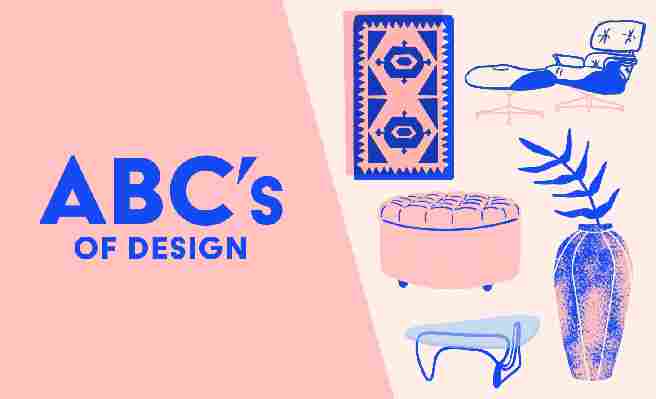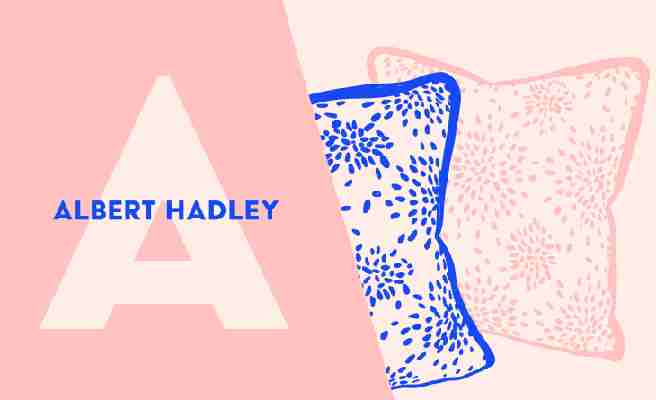
It’s no easy task: narrowing down the must-know interior design terms, styles, designers, and iconic products into a definitive 26-item list, one entry for each letter of the alphabet. It’s impossible actually, but we thought we’d give it a go because, hey, it’s fun.
Here’s to hoping you find a few of your design faves on this list—and that you get from a to zed learning at least one new fact to use as a conversation starter. Oh, and tell us in the comments what we should include in a potential version 2.0.

Albert Hadley: One half of the venerable Parish-Hadley Associates decorating firm (Sister Parish being the other), which rose to fame in the 20th century, Hadley is best known for being a high society designer and co-creator of the cult-classic “Fireworks” wallpaper by Donghia.
Bunny Williams: A celebrated New York City-based interior designer who is known for her new traditional style and various home decor product lines, from rugs to furniture.
Chintz: Colorful glazed calico florals popularized during the 1980s by designers like Mario Buatta, who was known as the “Prince of Chintz.”
Dorothy Draper: One of the most famous American interior decorators known for her use of stripes, bold patterns and crazy color combos. See her work, largely preserved and untouched, in some of the interiors of legendary hotel The Greenbrier in West Virginia.
Eames: A hallmark of “mid-century modern” design, this plywood-and-leather chair and ottoman set was design duo/husband and wife team Charles and Ray Eames’s modern answer to the 19th century club chair. Since launching at Herman Miller in 1956, the Eames chair and ottoman have been lauded for their simple, comfy forms and deemed an American Classic. The Eameses also designed an iconic plastic shell and metal chair, too, (you’ve seen it—for sure!) among other things.
Focal Point: An attention-grabbing feature in a room or on a wall. Examples include fireplaces, kitchen islands, statement lighting, artwork, etc.
Grommet: Typically on the tops of shower curtains and drapery, these circle-shaped eyelets—often made of sturdy metal—reinforce the holes used to hang fabric panels. Grommets can also be used decoratively on pillows or upholstery materials, and when used as such, give off slightly nautical vibes (probably because they’re also used on sailboats).
HomeGoods: How many times a week do you hit up this all things home discounted chain superstore? Do you also travel to other towns to find a mate for a lamp or chair you’ve found? Asking for a friend.
IKEA: The wildly popular Swedish home furnishings retailer, whose name stands for Ingvar Kamprad Elmtaryd Agunnaryd—the founder’s initials and hometown in Sweden. You probably have at least one IKEA (or IKEA-hacked) product in your space. Our bets are on the LACK table, MALM Dresser, or EXPEDIT bookcase.
Joanna Gaines: The Waco, Texas-based mother of “Farmhouse Modern” style forms half of the Magnolia Home duo (with husband Chip Gaines) that took the world by design storm on their HGTV show Fixer Upper. In addition to running a design and real estate business, Gaines has also grown her empire to include several New York Times best-selling books, a paint and wallpaper collection, a furniture line, and a carpets and textiles collection. She also opened the Silos in Waco, a complex with a home store, bakery, and small gardening nursery. Plus the couple has five cute kiddos!
Kilim: These flat woven rugs are great for high-traffic areas because they’re often colorful and patterned, which camouflages stains well.
Lanai: Sounds super fancy pants and glam, right? But it’s just a covered, screened-in porch.
Mid-Century Modern: A design style that rose to the forefront in the United States from roughly the 1940s to the late 1960s/early 1970s, which celebrated clean lines and simple silhouettes. Authentic MCM interiors and pieces also showcase and acknowledged their raw materials without artifice. Examples of furniture from the era include streamlined sofas with simple tapered wood legs, plastic shell chairs and plain-front cabinets for starters.
Noguchi: Isamu Noguchi was a Japanese American artist and landscape architect known for his large-scale sculptures and site specific public works. Like the Eameses and George Nelson, he collaborated with Herman Miller to put his mark on mid-century modern design, creating his iconic wood and glass coffee table, still in production today, as well as various paper lantern-style lamps and pendants.
Ottoman: A fabric-covered footstool that can also be used as a coffee table. Some feature decorative trim, tufting, and fabric skirts.
Patina: A distressed finish, typically on a vintage metal or wooden piece, that’s supposed to get better with age.
Quilt: A blanket or bed covering made of different scraps or patches of fabric. Quilts are usually associated with colonial style and simple folk interiors.
Rattan: Wood derived from climbing palm trees. Rattan furniture became popular in the 1970s and is experiencing a renaissance in today’s boho chic interiors.
Scandinavian Design: A popular design style that originated in the Scandinavian region (often defined as Sweden, Denmark, and Norway), and is known for its simple, clean-lined furniture, touches of nature, and pretty pale palette that heavily features white.
Toile: A figural pattern, typically on fabric or wallpaper, that tells a story in pictures.
Upholstery: Fabric covering for furniture that, at its best, is heavy-duty and stain-resistant. Common materials include velvet, damask, cotton, vinyl and leather.
Vanity: A small dressing table usually accompanied by a mirror, or the countertop, sink, and cabinet combination in a bathroom.
Wabi Sabi: The Japanese aesthetic principle of embracing the imperfect, which favors natural materials and handmade items over mass-produced goods.
X-Back: Stools, chairs, or benches that literally have an “x,” or cross-shape, on their backs or sides.
Yves Klein Blue: Also known as “international blue,” the pure ultramarine hue that artist Yves Klein developed for his art in the late 1950s. This deep, electric blue shade is still a popular accent color now.
Zig Zag: An abstract pattern or stitching style that consists of sharp, angular turns at regular increments. The chevron print, which never quite seems to go away, is made up of a series of zig zags.
